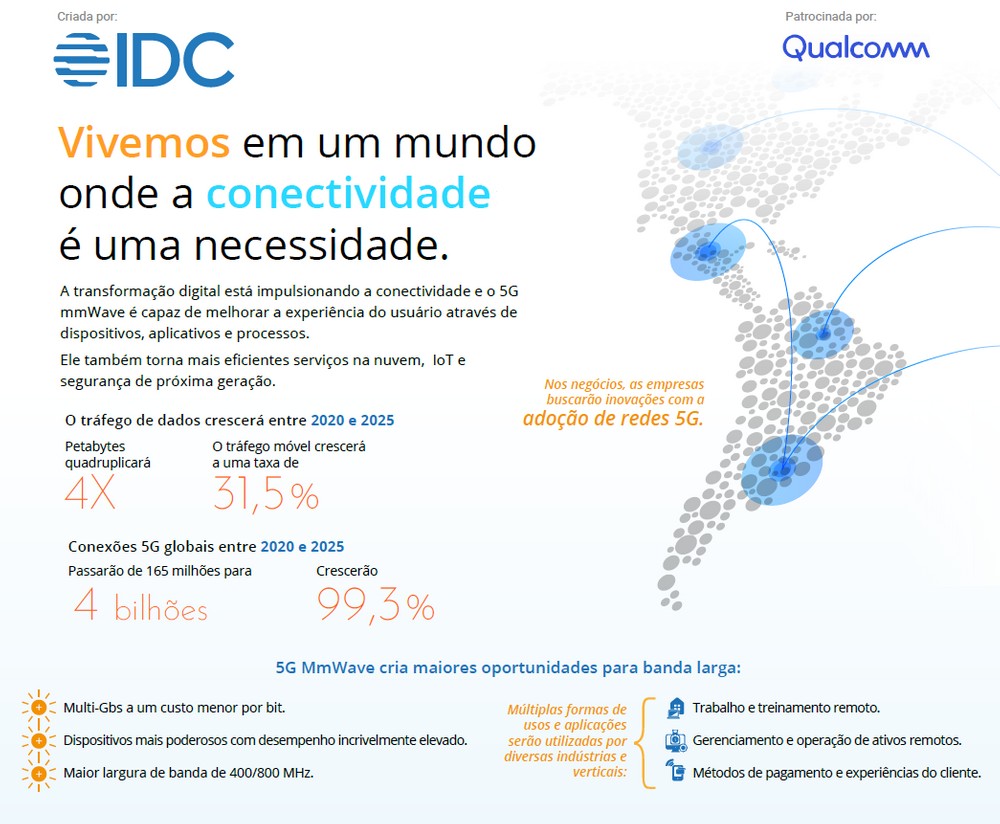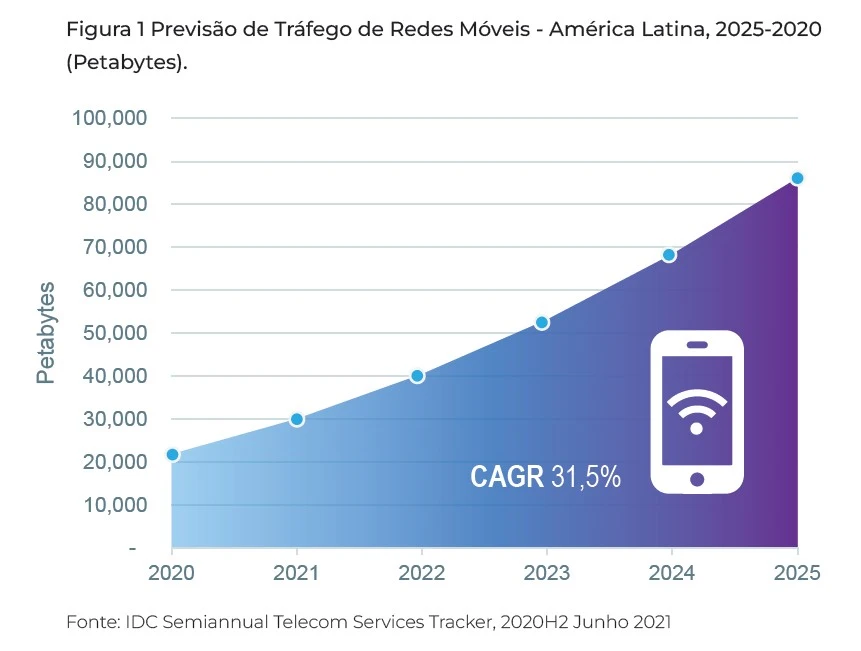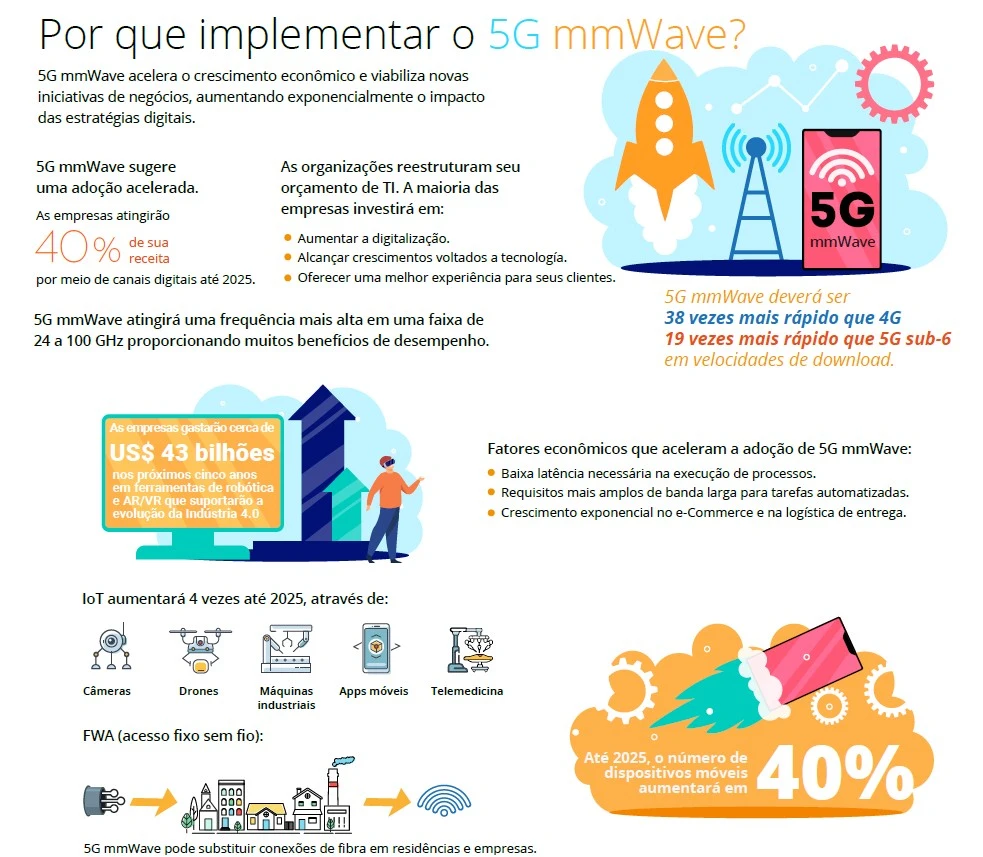
As we move forward with the implementation of 5G in Brazil and other Latin American countries, it becomes increasingly clear how the fifth generation of mobile internet will be able to completely change society and industry. Therefore, I would like to bring an extra layer to this discussion and talk about a technology that will revolutionize this whole context even more: millimeter waves, or mmWave.
According to the study “5G mmWave, a new era of opportunities in Latin America”, recently developed by IDC (International Data Corporation) in collaboration with Qualcomm, mmWave technology will be fundamental to meet the increasing demand for connectivity. According to the survey, global 5G connections are expected to grow from 165 million in 2020 to 4.4 billion in 2025, representing a compound annual growth rate of 99.3% — thus, a good part of fifth generation deployments. of the mobile internet in the world will be carried out in mmWave.
Image: Disclosure/Qualcomm and IDC
With the digital acceleration seen over the last couple of years, driven by the Covid-19 pandemic, the capacity and coverage of current networks could be under pressure in the short term due to significant and growing demand from residential, commercial and government users. To give you an idea, in 2020, more than 20,000 Petabytes of information were transferred through mobile networks, without considering the private 3G/LTE networks in Latin America. This data traffic will quadruple by 2025 and will grow at a compound annual rate (CAGR) of 31.5% over the same period.

Image: Disclosure/Qualcomm and IDC
Connectivity has therefore become a clear necessity, and a technology like 5G mmWave will be essential to accelerate the ongoing digital transformation. Specific tests have shown that millimeter wave 5G can be 38 times faster than 4G and up to 19 times faster than 5G sub-6, with respect to download speeds. In this way, the adoption will be important for the maintenance of remote work, entertainment, the adoption of telemedicine or for the implementation of Industry 4.0, in which factories and assemblers will be able to use mmWave technology in private networks to connect machines and robots, replacing the connection through of cables.

Image: Disclosure/Qualcomm and IDC
Millimeter wave (mmWave) is an essential element of 5G that reaches higher frequency bands, for example in the 24 GHz to 100 GHz range, as well as providing multiple benefits for performance. In Latin America, the potential of mmWave could accelerate the recovery of economies, enable new initiatives and business offerings, in addition to increasing the impact of digital strategies on organizations exponentially. The energy, retail, agriculture and livestock, financial and mining sectors are some of the sectors that will have the greatest impact with mmWave adoption.
What to Expect from 5G mmWave in Latin America
According to the research, the expectation is that millimeter waves in Latin America will obtain approximately 6GHz of band, distributed in two or three different bands. This means a revolution in business possibilities through 5G, both in consumer and business segments. IDC also estimates 5G mobile penetration in Latin America from 1.1% in 2020 to 25% in 2025, with a CAGR of 88%.
In practice, we have already witnessed some tests involving mmWave technology in countries like Brazil. Recently, Tim, in collaboration with Qualcomm, reached a new record in 5G Standalone tests in the country, by reaching a data transfer speed of 5.4 Gbps in its laboratory, 100 times greater than 4.5G and 100 times higher than recorded in 5G Dynamic Spectrum Sharing (DSS), using the entire existing band in the 26GHz band, which are millimeter waves.
During the Carnival samba school parades, this year held in April, Claro, in collaboration with TV Globo, Ericsson and Qualcomm, made a historic milestone by broadcasting the event using 5G mmWave. The action aimed to provide an agile and immersive experience for the viewer, who can follow the moment with even more quality and in real time. The images were captured by a cameraman using a backpack adapted with a 5G module for transmission, taking content in real time and with extreme quality to the final audience.
Competitive advantage
Operators that adopt millimeter waves will gain a significant competitive advantage by meeting the massive demand for mobile data, which will grow by about 31.5% over the next three years. Expanding 5G into industries that can benefit from diverse fixed wireless access (FWA) applications is a cost-effective way to deliver wireless fiber-like internet speeds with 5G mmWave to homes and businesses anywhere. FWA (Fixed Wireless Access) is also capable of providing fast and reliable connectivity and is a way to address “last mile” distribution challenges in rural areas.
In addition to enhancing connectivity, 5G with mmWave has the potential to achieve the fastest speeds and lowest possible latencies, making this mobile technology usher in new immersive experiences such as the metaverse, virtual and augmented reality, device gaming. mobile and video streaming. As we have seen, the potential of this technology is great and much is already being done to make its adoption happen quickly, allowing 5G to reach its full potential and revolutionize our lives.
—



